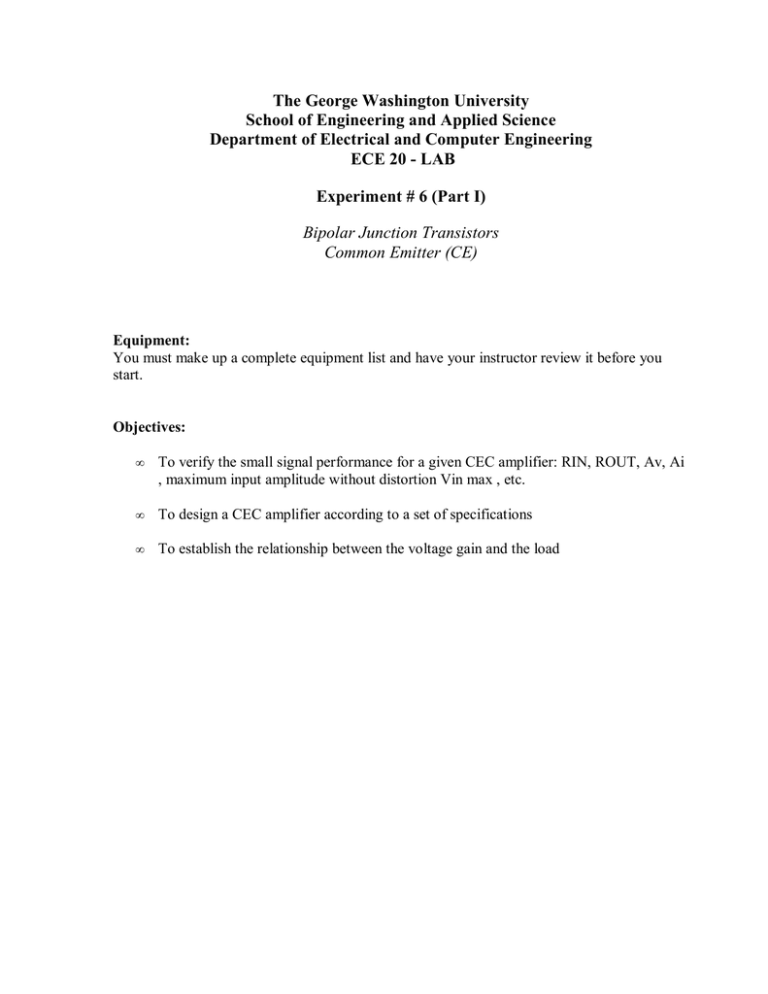Experiment #6a (Week 9) - SEAS | The George Washington University
advertisement

The George Washington University School of Engineering and Applied Science Department of Electrical and Computer Engineering ECE 20 - LAB Experiment # 6 (Part I) Bipolar Junction Transistors Common Emitter (CE) Equipment: You must make up a complete equipment list and have your instructor review it before you start. Objectives: • To verify the small signal performance for a given CEC amplifier: RIN, ROUT, Av, Ai , maximum input amplitude without distortion Vin max , etc. • To design a CEC amplifier according to a set of specifications • To establish the relationship between the voltage gain and the load 1.- (HW) Analysis The circuit below was analyzed in lab # 5. The values obtained for the bias currents and voltages remain the same. (VCC=30 VDC, =180, Vt=26mV): β The circuit below shows the BJT configured as a Common-Emitter (CE) Amplifier with a bypass capacitor (to increase the gain). This is also called: Common-Emitter Configuration (CEC). Using the hybrid- small-signal model for the BJT, and perform analysis to find (note Rsig is assumed to be 0): π 1. Find ROUT, RIN 2. Find Avo 3. Find Av by attaching a load resistor RL=ROUT (the value calculated in Step1), as in Fig #2. 4. Find Ais by attaching a load resistor RL=ROUT (the value calculated in Step1), as in Fig #2. 5. Find the maximum input voltage (Vsig max) that the amplifier can accept before the output distorts (loaded (RL=ROUT) and unloaded (no load resistor)). Figure #1 – BJT in Common Emitter Configuration with NO load 2.- Verification Build and fully test the circuit shown in Figure #1. By applying a sinusoidal signal (Vsig) such that the small signal approximation holds, measure: 1. RIN (input impedance) and ROUT (output impedance) of the assembled circuit. a. This cannot be done using DMM’s resistance function b. This cannot be done using DMM’s current function c. It must be done by treating your circuit as a two-port network, and putting a variable resistor (POT) in series with your two-port network (your GTA will explain this step). 2. Voltage gain Avo the assembled circuit in Fig #1 (the unloaded case) a. Be sure to set the scope to “AC” coupling when reading Vout. 3. Voltage gain Av for the assembled circuit in Fig #2 using the following values for RL: a. RL=ROUT (where the value of ROUT was calculated in Part 1) b. RL=2*ROUT c. RL=ROUT/2 d. RL=ROUT/4 4. Find the maximum input voltage (Vsig) that the amplifier can accept before the output distorts (loaded case). Plot the output signal and the corresponding input. 5. Determine the phase relationship between the input and output voltages. 6. Compare the measured results to your analysis calculations. Figure #2 – BJT in Common Emitter Configuration with Load Hint: On the scope, you will notice Vsig becomes very noisy. There is a feedback loop from the collector to the base, which is providing this noise. To filter out this noise use the digital scope’s bandpass filter on channel 1 of the scope. 3.- (HW) Design The figures 1 and 2 above, are examples of a Beta-Stabilized capacitively coupled Common Emitter voltage amplifiers (with shorting capacitor). Design a CE amplifier to meet the following specifications. Use SPICE to verify that all specifications have been achieved. Design Specifications of the Amplifier VCC = 30 VDC Av = -20 RL = 15 kΩ Ω RIN = 4 kΩ Ω You must find values for R1, R2, & RC to meet the above specifications. You may assume: β =180, Vt=26mV VE=.2 * VCC (VE is the voltage at the emitter) I1 = 10 * IB (I1 is the current through resistor R1) meaning I1 >> IB RB >> r π 100K< R1 <1000K 100K< R2 < 1000K Hints: Use the value you find for r , to find gm (realize that gm will be different than it was for the circuits in Fig 1 and 2). Once you have gm, you can quickly find Rc! π 4.- Assembly, Test and Verification of Specifications Build and test your design. Measure and verify that your design meets all the given specifications. a. Measure VBE, VE, VB, VC, VCE, IB, IE, and IC with no input. b. Measure Av, Rin (input impedance) and Rout (output impedance) of the assembled circuit. (use the technique described in section 2.1 of the lab) c. Find the maximum input voltage that the amplifier can accept before the output distorts. d. Measure the phase relationship between the input and output voltages. 5.- Conclusion a. Considering that these amplifiers are quite typical, what can you say about Rin, Rout, and the Av for the CEC amplifier? Is this a unilateral or non-unilateral amplifier? b. Why is there always a big difference between the value the function generator was set for and the actual input signal? c. Compare the measured results to your design calculations and specifications. Explain any and all differences!


